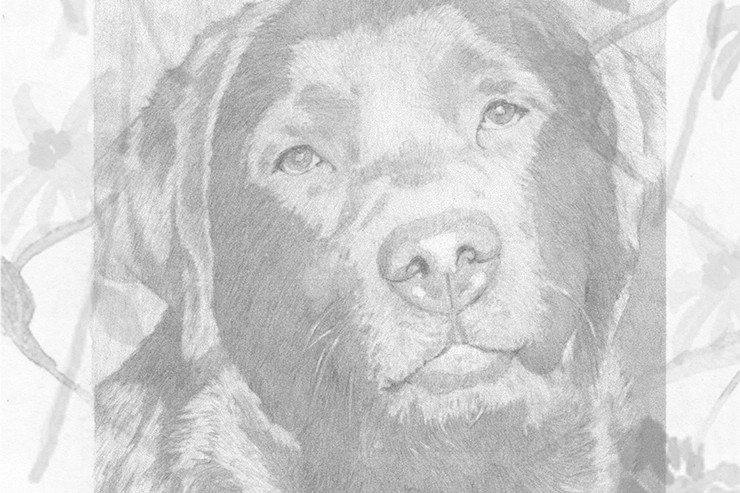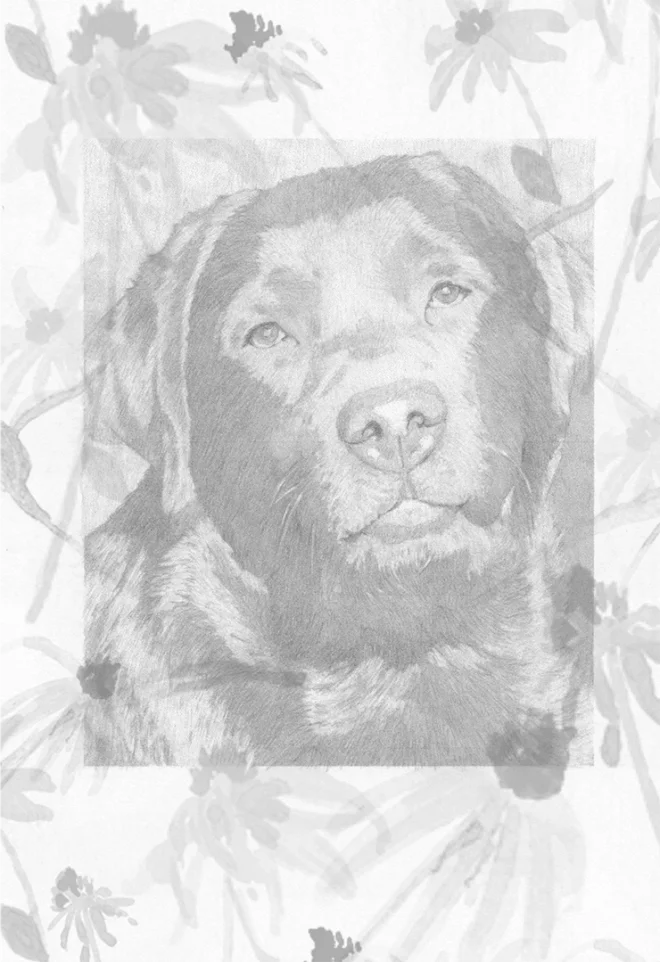
Did you know that there are entire books written for dogs in the garden? They call it dogscaping!
This past spring we lost our pup suddenly at the youthful age of 10—practically middle-aged for a Goldendoodle. And while today’s story is about a lovely dog and the garden she loved, my story is a little different. My garden terrorist, the apple of my eye, and first baby of our family will not be buried under his favorite apple tree or anything so wholesome.
This guy would dig up my plants, pee on my beds, eat my tomatoes, chase squirrels through them as if they were freshly cut grass, and couldn’t tell the difference between a raised bed and a hill. His greatest joy was jumping up inside the 30″ tall beds, plunging his nose into the soil, and walking in the door with a dirty nose and big innocent brown eyes. Had he been here to frolic this summer, he’d have been awfully disappointed to see I used weed fabric for the first time, but equally challenged to tear it all up.
So I miss having my fluffy buddy by my side, but my garden has never been better.
As it turns out, not all dogs are garden enemy #1. In today’s story “Barley Flowers,” their family dog Barley is the light of the garden. Their child even calls the black-eyed Susans “Barley flowers” because she loves to roll in them, and it seems to make them grow even better. After she passes, the black-eyed Susans never quite grow the same again. If you have a pet in your life who enjoys a romp in the garden, you might enjoy today’s story as much as I did.
More Stories About Dogs in the Garden
This story comes from our archive that spans over 30 years and includes more than 130 magazine issues of GreenPrints. Pieces like these that turn gardening stories into everyday life lessons always brighten up my day, and I hope this story does for you as well. Enjoy!

Barley Flowers
A dog you could name a flower for.
By Leah Hoenen
When my husband landed his dream job, we gleefully packed our bags and headed north to Maine, where we’d always wanted to live. We hadn’t looked very long before we found a sweet, neglected old Cape. Despite our hopes for a magazine-style backyard garden, we spent all our time running back and forth to the hardware store—and not a minute planting. As luck would have it, our garden itself took care of welcoming us to our new digs. With no attention from us, mallows sprang up all over. Siberian irises danced with Solomon’s seal. A gregarious flock of wild violets ran willy-nilly from the hedge into the yard. Daisies popped up in the pastures. What a windfall for an unmotivated gardener like me!
We brought our two dogs, Barley, an abnormally enthusiastic chocolate Lab, and Beagle the Beagle, who absolutely relished the northern climate. After years spent languishing on couches in air-conditioned apartments in the steamy mid-Atlantic, they were finally free to romp through the woods, crash into the waves of the bay, and wallow in woodland brooks—before sleeping the afternoon away on that shady carpet of violets. They were leash-free and loving life. Our free-range flowers ran free, too, taking over yard and pasture with abandon and bringing with them a profusion of bees and songbirds.
In our second year, black-eyed Susans arrived; they moved into the pastures before they migrated up to the house. They were absolutely everywhere, so one day on a whim I bought Barley a collar to match. A necklace of yellow flowers nestled into her fluffy brown fur was perfect for a happy-go-lucky dog in our new land of wildflowers.

The years spent in that house were short, but they were full and they were joyful. We four—Karl, me, and the dogs—found ourselves watching over horses, chickens, sheep and lambs, and all those glorious flowers. Long and hard though they were, the days were our happiest yet. We welcomed a baby into our family, but we remained a quad, for our dear Beagle left us soon after our son arrived. Barley was middle-aged when we moved and by the time Anders was born, she was spending more time snoozing in the violets and less time chasing turkeys. We mounted an impressive attack on the symptoms of her aging, but though the slide is slow, it is sure. One Summer she just stopped doing chores with us. Yes, she still swam some in the bay, but many days, she was too uncomfortable to do much at all. She seemed content to watch the lambs race and the baby start to walk. He toddled around and kicked a soccer ball to her. She’d gently nose it back to him.
That year flowers had so overgrown our walkway that we needed to cut them back to access the house. Barley nosed her way into this wild garden and made a soft dirt bed shaded by the leaves and sunny faces of black-eyed Susans. When little Anders began to talk, he started with the names of flowers, first identifying “dandies,” or dandelions, and then “Barley flowers,” the black-eyed Susans. She wore them around her neck and slept in them all day. The name made perfect sense.
And now you, dear reader, must know just where this story is headed. In the midst of that magical, flowering Summer, we recognized we were unable to control her pain, and so we steeled ourselves and picked a date.
Our last day together, at Summer’s end, was glorious—warm and dry. We played on the beach and laid together in the shade. Then I held her close and told her how dearly I loved her as she lay on our cool kitchen floor and breathed her last.
The departure of her soul shattered my heart—that sweet, gentle creature into whose warm brown fur I’d happily nestled my fingers for so many years was my shadow, my friend, a soul-mate—and I’ve never felt more alone than I did in those first moments without her. I sat outside in the hours after her death, looking miserably all around, and in spite of the birds and the bees and the lambs, the silence I felt was overwhelming.
As the days went by, we picked ourselves up bit by bit and, busied by a baby bobbing around, watched the seasons change. The first year without someone is full of constant reminders, but it seemed each milestone marked without her was less horrible than the last, although the pain caused by her absence has never really abated.
When the Spring returned again, pink mallows again peppered the lawn and motherwort spread its intoxicating fragrance through the air. But it felt different. You could never accuse our garden of being anything less than beautiful, but in Barley’s absence it seemed far from spectacular. The violets retreated into the deep shade, and the black-eyed Susans never again tried to take over the yard like they had that one year. Of course, the roses bloomed and the clematis flourished. We even grew tomatoes. But without the contagious enthusiasm of our happy dog and her boundless energy, it felt like there was less energy around us.
The sadness of grief is deep and lasting, but its clarifying effects are powerful. In the intervening years, we have talked every Summer about the season our garden ran wild, and each time we are overtaken by the wonderful kind of nostalgia that brings huge smiles and happy tears. It’s the kind that makes you forget the work and the fatigue in favor of the triumphs and successes—and focus instead on the fortune that brings you things like magical self-sustaining gardens and best friends with soft chocolate-colored fur coats. It’s the kind of memory that reminds you how beautiful home and garden always are, of what makes them beautiful, and how absolutely lucky you are sometimes in the companions you are given. ❖
By Leah Hoenen, published originally in 2019, in GreenPrints Issue #119. Illustrated by Heather Graham

Do you have a similar story about dogs in the garden that this reminds you of that you’d like to share? Leave a comment!




Nicely written
This, so beautifully told. I share in your sorrow over your loss as well. The artwork is absolutely felt deep into my soul. God bless you all!